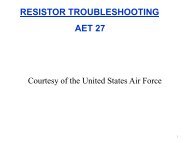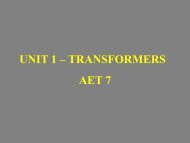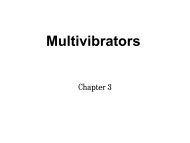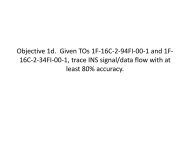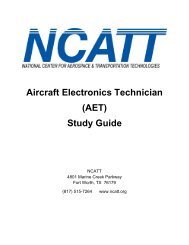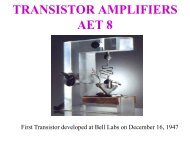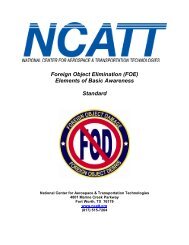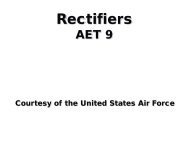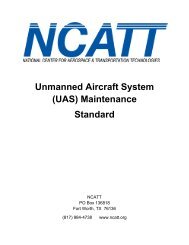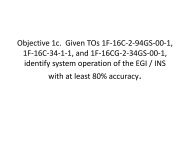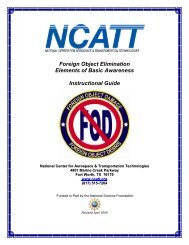Aircraft Electronics Technician AET - NCATT
Aircraft Electronics Technician AET - NCATT
Aircraft Electronics Technician AET - NCATT
Create successful ePaper yourself
Turn your PDF publications into a flip-book with our unique Google optimized e-Paper software.
<strong>NCATT</strong> <strong>Aircraft</strong> <strong>Electronics</strong> <strong>Technician</strong> (<strong>AET</strong>) Study Guide<br />
• Consult aircraft specifications and standards to determine engine type design and<br />
limitations, as well as other important information<br />
Additional documents to consult or refer to:<br />
• Consult FAA Airworthiness Directives (ADs) for unsafe conditions found in aircraft<br />
engines, propellers, or appliances<br />
o Airworthiness Directives (Ads) also provide the timeframe for compliance<br />
o FAA publishes a summary of ADs every two years<br />
o Consult FAA document, AC 43.13-1B/2B, if no maintenance manual exists for<br />
maintaining an aircraft<br />
o Consult Federal Aviation Regulation 14 CFR Part 43 for regulatory requirements<br />
concerning Maintenance, Preventive Maintenance, Rebuilding, and Alterations<br />
o Consult Federal Aviation Regulation 14 CFR Part 65 for regulatory requirements<br />
for certified airmen (mechanic and repairman) privileges and limitations<br />
Interpretation Notes: Check the Table of Contents. Check the index for subjects and details.<br />
Read the title of the chapter and headings for the main idea. Break down the whole into parts.<br />
Refer to the symbols in the legend or key on a drawing or document. Read the labels and callouts<br />
on a drawing. Scan a drawing or document to quickly find information. Compare with other<br />
types of information to see relationships. Locate terms in the glossary or an aeronautical<br />
dictionary. Search the document online or on a CD or DVD, if available.<br />
Interpret Technical Data:<br />
Examples of technical data include manufacturer’s service bulletins, service letters, and service<br />
instructions to notify aircraft owners of design defects and product improvements. Individuals<br />
should be able to explain how to interpret technical data with reference to the following terms:<br />
• Schematic Diagrams<br />
o Show an electrical or fluid power system<br />
o The components are represented by symbols rather than drawings or pictures of<br />
the actual devices<br />
o Schematic Diagrams do not necessarily show the locations of a system<br />
o These diagrams are used mainly for troubleshooting<br />
• Block Diagrams<br />
o Shows functional units represented by blocks<br />
o Each block describes a function of a system and shows its relationship to other<br />
units in the system<br />
o The energy flow direction, or association, within the system is shown with arrows<br />
o Block diagrams are high level diagrams used for troubleshooting or teaching a<br />
process<br />
• Installation Diagrams<br />
Copyright © 2012 by the National Center for Aerospace & Transportation Technologies. All rights reserved. Individuals may<br />
download, print, and make copies of this document for their own personal use. Commercial use prohibited.<br />
Page 41 of 60




